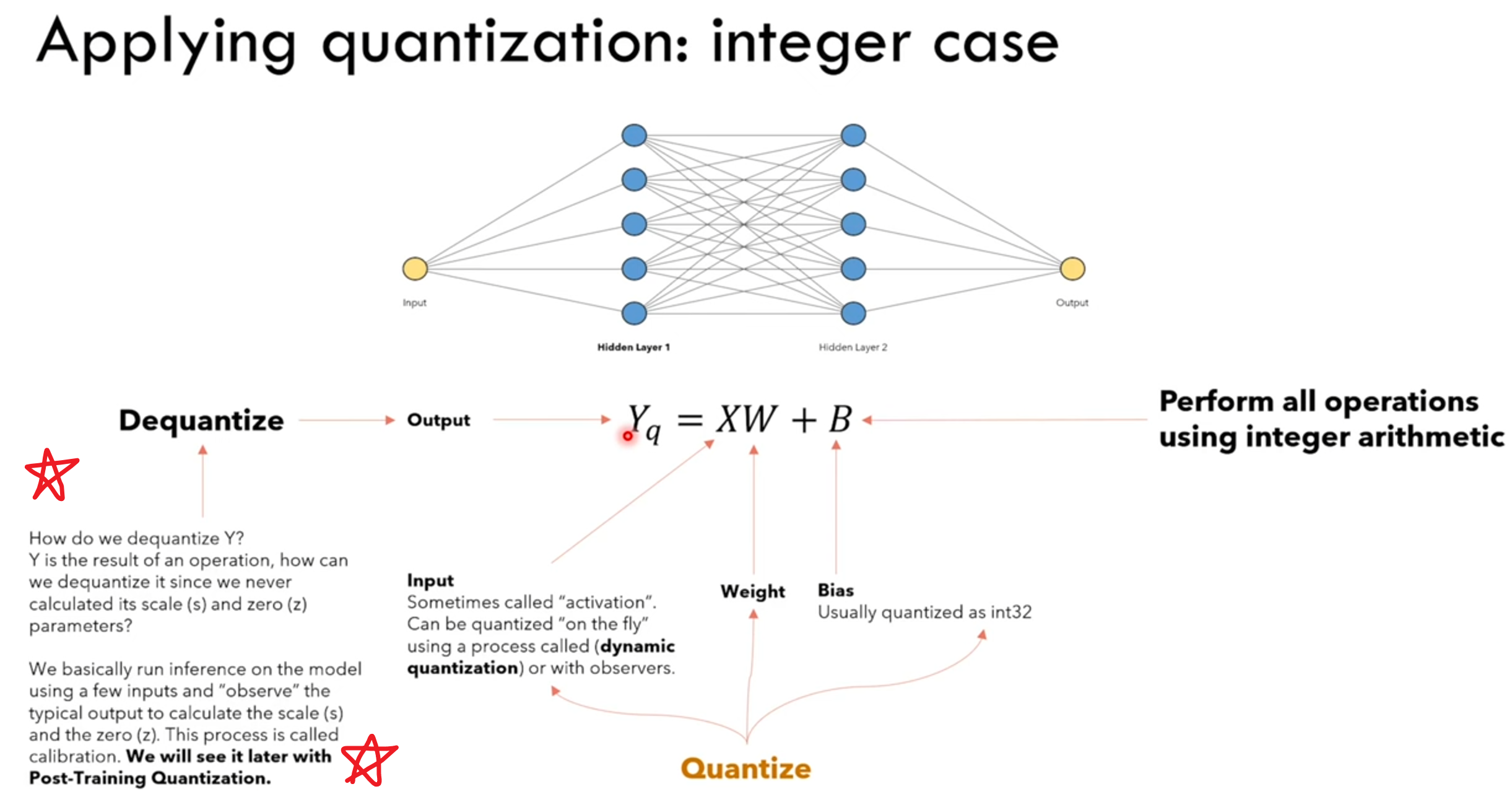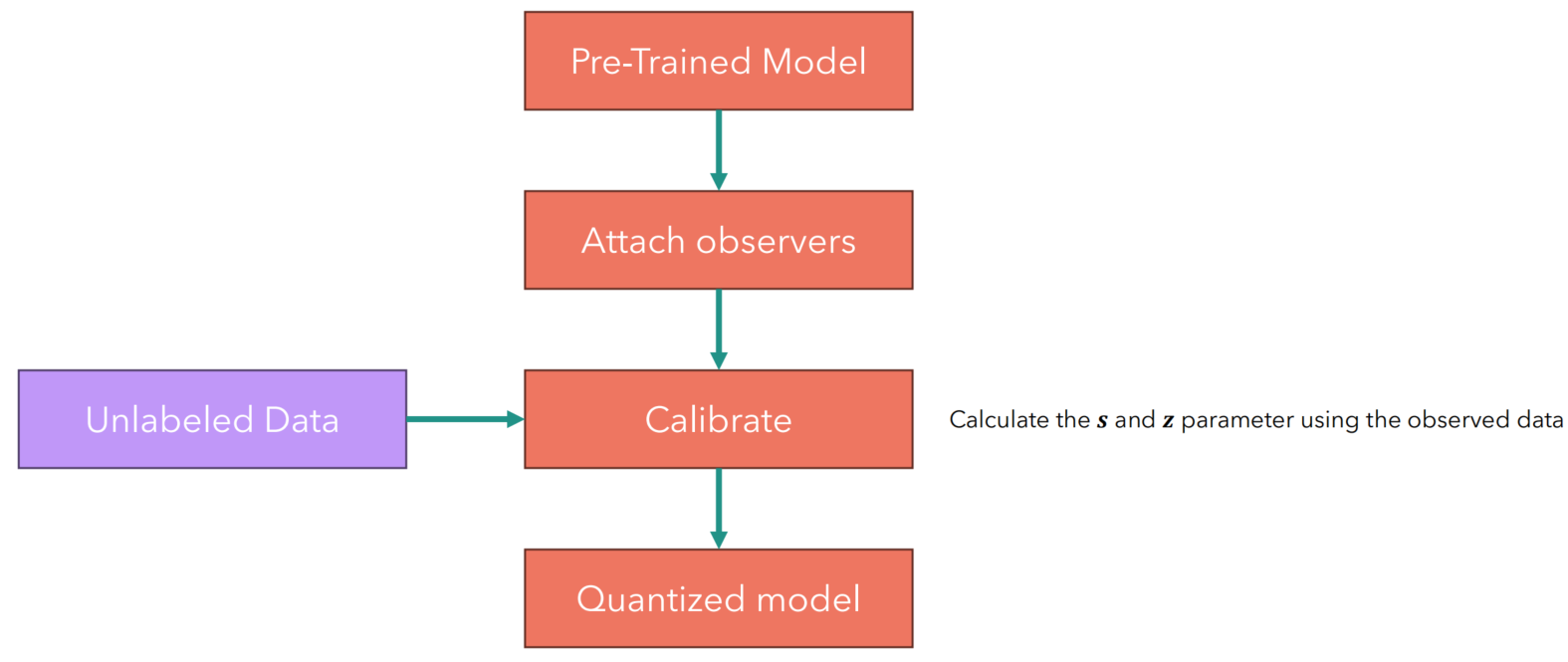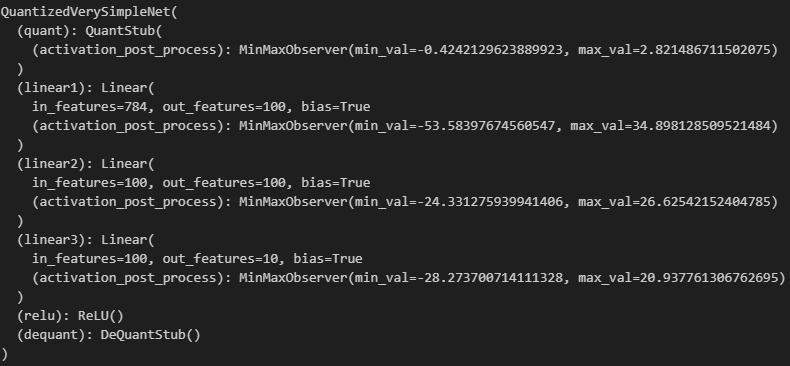训练后量化(Post-training Quantization,PTQ)是一种常见的模型量化技术,它在模型训练完成之后应用,旨在减少模型的大小和提高推理速度,同时尽量保持模型的性能。训练后量化对于部署到资源受限的设备上,如移动设备和嵌入式设备,特别有用。
在我们量化时,量化操作可以应用于模型的输入、权重 和 激活(即神经元输出值)上。
但我们发现,对于激活值,我们执行反量化时,并不知道这些激活值对应的浮点数矩阵的最大值和最小值,即我们执行非对称或对称量化里面的 𝛼, β 参数,所以我们拿到一个模型时,最多只能对它的权重W和输入X做量化,对于激活值Y的反量化,我们需要一组小的calibration set数据来初步计算对于Y的S和Z参数。
不熟悉非对称或对称量化的朋友可以康康这篇:《模型量化(一)—— 非对称量化、对称量化(全代码)》

目录
- PTQ流程:
- 全代码
- 预训练模型
- 加入Observer
- 校准模型
- 量化模型
PTQ流程:

Observer,顾名思义就是模型在正常inference的时候会被记录下正常的浮点激活值,用来算激活值对应的S和Z参数。
Calibrate后模型的W和Y都有对应的S和Z了,模型名义上量化完成。浮点的输入X也能off-line地实时算它对应的S和Z。
所以量化后的模型运行时,先对浮点输入进行量化,然后与整型的W矩阵相乘,得到整型的激活值,这时再反量化为浮点激活值,对应于下一个神经元的浮点输入,依次循环。
大家可能会想吗,这么麻烦,又是量化又是反量化,怎么还会压缩模型和加速模型呢?
压缩模型:原本所有的W都是浮点数存储,比如float32,现在转换为int8存储,模型尺寸减了大概4倍;再额外存一些神经元或网络层的S和Z参数(取决于量化的粗粒度),相对于W来说占内存很小(如果是很细粒度的量化可能这部分也得好好考虑,量化的粒度分为权重级量化、层级量化、通道级量化等)。
加速模型:主要的收益是使得模型中占大头的 W * X 操作变成了整型相乘,功耗和时延最低(浮点数相乘时功耗和时延最大)。3 * 100 * 100 * 10的全连接网络中,有213个神经元,但是有 3 * 100 * 100 * 10 = 300M个参数!这还是忽略了bias。量化相当于就是让这 300M 次乘法更轻量。而相对的 overhead 就是对开头的3个输入进行一下量化 和 对210和神经元的输出进行一下反量化,这部分开销随着网络层数与参数的增加几乎可以忽略不计。
一些专门的深度学习加速器和现代CPU/GPU提供了对低位宽整数(如int8)的优化支持,用这些硬件后可以更加体现模型量化的优势。
量化会带来一定的量化误差,即模型精度会受影响,这肯定的,但按经验来说几乎没什么影响,不要压到int4或int2这么极限就行。
全代码
预训练模型
import torch
import torchvision.datasets as datasets
import torchvision.transforms as transforms
import torch.nn as nn
import matplotlib.pyplot as plt
from tqdm import tqdm
from pathlib import Path
import os# Make torch deterministic
_ = torch.manual_seed(0)transform = transforms.Compose([transforms.ToTensor(), transforms.Normalize((0.1307,), (0.3081,))])# Load the MNIST dataset
mnist_trainset = datasets.MNIST(root='./data', train=True, download=True, transform=transform)
# Create a dataloader for the training
train_loader = torch.utils.data.DataLoader(mnist_trainset, batch_size=10, shuffle=True)# Load the MNIST test set
mnist_testset = datasets.MNIST(root='./data', train=False, download=True, transform=transform)
test_loader = torch.utils.data.DataLoader(mnist_testset, batch_size=10, shuffle=True)# Define the device
device = "cpu"# Define the model
class VerySimpleNet(nn.Module):def __init__(self, hidden_size_1=100, hidden_size_2=100):super(VerySimpleNet,self).__init__()self.linear1 = nn.Linear(28*28, hidden_size_1) self.linear2 = nn.Linear(hidden_size_1, hidden_size_2) self.linear3 = nn.Linear(hidden_size_2, 10)self.relu = nn.ReLU()def forward(self, img):x = img.view(-1, 28*28)x = self.relu(self.linear1(x))x = self.relu(self.linear2(x))x = self.linear3(x)return xnet = VerySimpleNet().to(device)# Train the model
def train(train_loader, net, epochs=5, total_iterations_limit=None):cross_el = nn.CrossEntropyLoss()optimizer = torch.optim.Adam(net.parameters(), lr=0.001)total_iterations = 0for epoch in range(epochs):net.train()loss_sum = 0num_iterations = 0data_iterator = tqdm(train_loader, desc=f'Epoch {epoch+1}')if total_iterations_limit is not None:data_iterator.total = total_iterations_limitfor data in data_iterator:num_iterations += 1total_iterations += 1x, y = datax = x.to(device)y = y.to(device)optimizer.zero_grad()output = net(x.view(-1, 28*28))loss = cross_el(output, y)loss_sum += loss.item()avg_loss = loss_sum / num_iterationsdata_iterator.set_postfix(loss=avg_loss)loss.backward()optimizer.step()if total_iterations_limit is not None and total_iterations >= total_iterations_limit:returndef print_size_of_model(model):torch.save(model.state_dict(), "temp_delme.p")print('Size (KB):', os.path.getsize("temp_delme.p")/1e3)os.remove('temp_delme.p')MODEL_FILENAME = 'simplenet_ptq.pt'if Path(MODEL_FILENAME).exists():net.load_state_dict(torch.load(MODEL_FILENAME))print('Loaded model from disk')
else:train(train_loader, net, epochs=1)# Save the model to disktorch.save(net.state_dict(), MODEL_FILENAME)# Define the testing loop
def test(model: nn.Module, total_iterations: int = None):correct = 0total = 0iterations = 0model.eval()with torch.no_grad():for data in tqdm(test_loader, desc='Testing'):x, y = datax = x.to(device)y = y.to(device)output = model(x.view(-1, 784))for idx, i in enumerate(output):if torch.argmax(i) == y[idx]:correct +=1total +=1iterations += 1if total_iterations is not None and iterations >= total_iterations:breakprint(f'Accuracy: {round(correct/total, 3)}')# Print weights and size of the model before quantization# Print the weights matrix of the model before quantization
print('Weights before quantization')
print(net.linear1.weight)
print(net.linear1.weight.dtype)print('Size of the model before quantization')
print_size_of_model(net)print(f'Accuracy of the model before quantization: ')
test(net)
加入Observer
# Insert min-max observers in the modelclass QuantizedVerySimpleNet(nn.Module):def __init__(self, hidden_size_1=100, hidden_size_2=100):super(QuantizedVerySimpleNet,self).__init__()self.quant = torch.quantization.QuantStub()self.linear1 = nn.Linear(28*28, hidden_size_1) self.linear2 = nn.Linear(hidden_size_1, hidden_size_2) self.linear3 = nn.Linear(hidden_size_2, 10)self.relu = nn.ReLU()self.dequant = torch.quantization.DeQuantStub()def forward(self, img):x = img.view(-1, 28*28)x = self.quant(x)x = self.relu(self.linear1(x))x = self.relu(self.linear2(x))x = self.linear3(x)x = self.dequant(x)return xnet_quantized = QuantizedVerySimpleNet().to(device)
# Copy weights from unquantized model
net_quantized.load_state_dict(net.state_dict())
net_quantized.eval()net_quantized.qconfig = torch.ao.quantization.default_qconfig
net_quantized = torch.ao.quantization.prepare(net_quantized) # Insert observers
net_quantized
校准模型
#用测试集再跑一次装了observer的模型
test(net_quantized)print(f'Check statistics of the various layers')
net_quantized

这时看到激活层的 𝛼, β 都有了,good!
量化模型
# Quantize the model using the statistics collectednet_quantized = torch.ao.quantization.convert(net_quantized)print(f'Check statistics of the various layers')
net_quantized

# Print the weights matrix of the model after quantization
print('Weights after quantization')
print(torch.int_repr(net_quantized.linear1.weight()))# Compare the dequantized weights and the original weights
print('Original weights: ')
print(net.linear1.weight)
print('')
print(f'Dequantized weights: ')
print(torch.dequantize(net_quantized.linear1.weight()))
print('')# Print size and accuracy of the quantized model
print('Size of the model after quantization')
print_size_of_model(net_quantized)
print('Testing the model after quantization')
test(net_quantized)


![中间件 | Kafka - [常见问题]](http://pic.xiahunao.cn/中间件 | Kafka - [常见问题])

)



strcpy与strcpy详解,与模拟实现)










